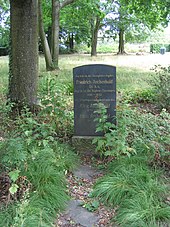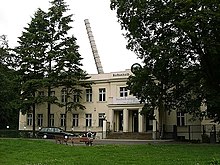Friedrich Simon Archenhold
Friedrich Simon Archenhold (born October 2, 1861 in Lichtenau in East Westphalia , † October 14, 1939 in Berlin ) was an astronomer and co-founder of the Archenhold observatory, named after him since 1946, in what was then the rural community of Treptow near Berlin (today in the Berlin district of Alt-Treptow ).
Live and act
Friedrich Simon Archenhold passed his Matura exam at the 1st class secondary school in Lippstadt (today Ostendorf-Gymnasium) at Easter 1882 and studied from 1882 to 1887 in Berlin and Strasbourg .
His former professor, Wilhelm Foerster , supported him in his research. In 1889 Archenhold became the first astronomer at the Urania public education institute in Berlin, which was co-founded by Foerster and inaugurated that year . In 1890 he became an employee of the Berlin observatory , of which Foerster was director, and on his behalf set up a photographic branch at Halensee in Grunewald. On October 27, 1891, he discovered an extensive nebula (the Perseus Nebula) near the star ξ-Persei in the constellation Perseus with the help of photography and published this discovery in the Astronomical News .
Difficulties due to a lack of technical means in proving that it was an independent nebula probably led Archenhold to plan for a new large telescope . On the basis of his planning and in the course of the preparations for the Berlin trade exhibition in 1896, the telescope - sometimes called the sky cannon - with a focal length of 21 m , the longest lens telescope on earth to this day, was created.
The Berlin trade exhibition opened on May 1, 1896, but the telescope was not finally completed until September, under the direction of Archenhold. Due to the large number of visitors to the telescope and the great interest of many sections of the population, the decision was made to leave the telescope and the surrounding building in Treptower Park . This was in fact the foundation of the Volkssternwarte, which was then called the Treptow Observatory and has been called the Archenhold Observatory since 1946 .
In 1898, the Treptow-Sternwarte e. V. founded the observatory and whose chairman was Archenhold. On the one hand, Archenhold held many lectures in the observatory and outside and on the other hand was responsible for the operation and financing. In 1912 he had the idea of using films as a medium for imparting knowledge in the observatory.
Archenhold made several trips to solar eclipses and carried out research on the nature of sunspots . In 1904 he met Andrew Carnegie for the first time in England , who later also visited the Treptow Observatory in Berlin. In 1907 he made a long trip to the USA , where he met, among others, Thomas Alva Edison , Simon Newcomb , Edward Charles Pickering and Williamina Fleming . During this trip he also received an honorary doctorate from the Western University of Pennsylvania . Archenhold was involved in the Berlin program of the physics of the high atmosphere with Otto Jesse and Wilhelm Foerster . He observed Glowing Night Clouds at the observatory and worked closely with Jesse.

Archenhold was able to attract numerous well-known scientists and researchers to lectures in the observatory, one of the most important lectures in retrospect is likely to have been Albert Einstein's first public lecture on the theory of relativity on June 2, 1915 . Archenhold was an opponent of the war and sympathized with the New Fatherland Confederation founded in 1914 . In 1925, when the Panterra company was founded, Archenhold became managing director alongside the 1st chairman Professor Kapp and the 2nd chairman Rudolf Nebel .
Archenhold became honorary chairman of the Berlin aviation club founded on July 17, 1928 , which wanted to promote aviation in every direction. In 1931, on his 70th birthday, Archenhold resigned from the position of director. He was succeeded by his son Günter Archenhold (1904–1999). Friedrich Simon Archenhold's grave is located in the middle of the state's own central cemetery in Friedrichsfelde .
Friedrich Simon Archenhold was married to Alice Archenhold (born August 27, 1874) since July 1897. The couple had five children. With the seizure of power of the Nazis in 1933 there were attacks against the Jewish family Archenhold. Alice Archenhold and her daughter Hilde were arrested by the National Socialists and deported to the Theresienstadt concentration camp , where both perished. Alice Archenhold died on February 9, 1943. On the anniversary of her death in 2010, a street in Berlin-Niederschöneweide was renamed after her.
Honors
After the observatory was given the honorary name of its founder in 1946, the GDR had sculptor Theo Balden carved a granite bust . The bust was placed in front of the main building of the observatory in 1961.
In 1999 the asteroid (4030) Archenhold was named after Friedrich Simon Archenhold.
A grammar school in Berlin-Niederschöneweide has been called Archenholds since October 14, 1992 .
Works
- Editor and founder of the magazine Das Weltall (1900–1944)
- Raphael Loewenfeld (Hrsg.): Congress for popular entertainment. Popular entertainment; Lectures and reports by FS Archenhold, Albert Dresdner [et al.] Stenographic report on the First Congress… on November 13th & 14th, 1897 in Berlin. Berlin: F. Duemmler, 1898 (location: Leo Baeck Institute New York)
- Friedrich Simon Archenhold produced the world's first solar eclipse film together with Oskar Messter in 1912.
literature
- Reichs Handbuch der Deutschen Gesellschaft - The handbook of personalities in words and pictures , first volume, Deutscher Wirtschaftsverlag, Berlin 1930, p. 32, ISBN 3-598-30664-4 .
- Felix Schmeidler : Archenhold, Friedrich Simon. In: New German Biography (NDB). Volume 1, Duncker & Humblot, Berlin 1953, ISBN 3-428-00182-6 , p. 335 ( digitized version ).
- Dieter B. Herrmann : Friedrich Simon Archenhold and his Treptower observatory . Lectures and writings from the Archenhold Observatory No. 65, Berlin-Treptow 1986 (40 pages, 80 references).
- Andreas W. Daum: Science popularization in the 19th century. Civil culture, scientific education and the German public, 1848–1914 . Oldenbourg, Munich 1998, ISBN 3-486-56337-8 .
Web links
- Literature by and about Friedrich Simon Archenhold in the catalog of the German National Library
- Archenhold's works. Search hits. In: ui.adsabs.harvard.edu. Astrophysics Data System
- Förderverein AStW and ZGP Berlin e. V. In: astw.de.
- Illustration of a brochure on the return of Halley's Comet by Archenhold
Individual evidence
- ^ Andreas W. Daum: Science popularization in the 19th century. Civil culture, scientific education and the German public, 1848–1914 . Oldenbourg, Munich 1998, ISBN 3-486-56337-8 , pp. 178-181, 473 .
- ↑ Dieter B. Herrmann, On the Value of Film for Education. Initiatives of the Treptower observatory and the Berlin and Vienna Urania (1904–1924) In: Rolf Aurich u. Ralf Forster (ed.): How the film became immortal. Pre-academic film studies in Germany, Munich 2015, pp. 142–149
- ↑ Gabriele Schöttler: Renaming of the street in Niederschöneweide. In: www.berlin.de. February 20, 2010, archived from the original on February 20, 2010 ; accessed on August 5, 2019 .
- ↑ Institute for Monument Preservation (Ed.): The architectural and art monuments of the GDR. Capital Berlin-II . Henschelverlag, Berlin 1984, p. 368/369 .
- ↑ MINOR PLANET CIRCULARS / MINOR PLANETS AND COMETS. (PDF; 3 MB) In: minorplanetcenter.net. Minor Planet Center, Smithsonian Astrophysical Observatory, Cambridge, MA 02138, USA, April 2, 1999, p. 252 , accessed August 5, 2019 .
- ^ School history - Archenhold-Gymnasium Berlin. In: pi.archenhold.de. Retrieved August 5, 2019 .
- ↑ Konrad Guhl: Observations on the Great Refractor . Publication of the Friends of the Archenhold Observatory No. 6, Berlin 2004.
| personal data | |
|---|---|
| SURNAME | Archenhold, Friedrich Simon |
| BRIEF DESCRIPTION | German astronomer and co-founder of the Archenhold observatory named after him in Berlin-Treptow |
| DATE OF BIRTH | October 2, 1861 |
| PLACE OF BIRTH | Lichtenau (Westphalia) |
| DATE OF DEATH | October 14, 1939 |
| Place of death | Berlin |


